Analysis of Economic Systems, Market Structures, and Global Trade
VerifiedAdded on 2023/01/11
|12
|3597
|61
Report
AI Summary
This report provides a comprehensive analysis of various economic systems, including mixed, free market, and command economies, detailing their resource allocation methods. It examines the roles of fiscal and monetary policies and their impact on business organizations, using Primark as a case study. The report delves into different market structures, such as perfect competition, monopoly, and oligopoly, explaining their pricing and output decisions. It also explores how market forces like demand, supply, employees, customers, and suppliers shape organizational responses. Furthermore, the report discusses the business and cultural environment of the UK and its influence on Primark's behavior, considering political, economic, socio-cultural, technological, environmental, and legal factors. Finally, it highlights the significance of international trade to UK businesses, emphasizing its role in innovation, technological advancements, and network expansion.
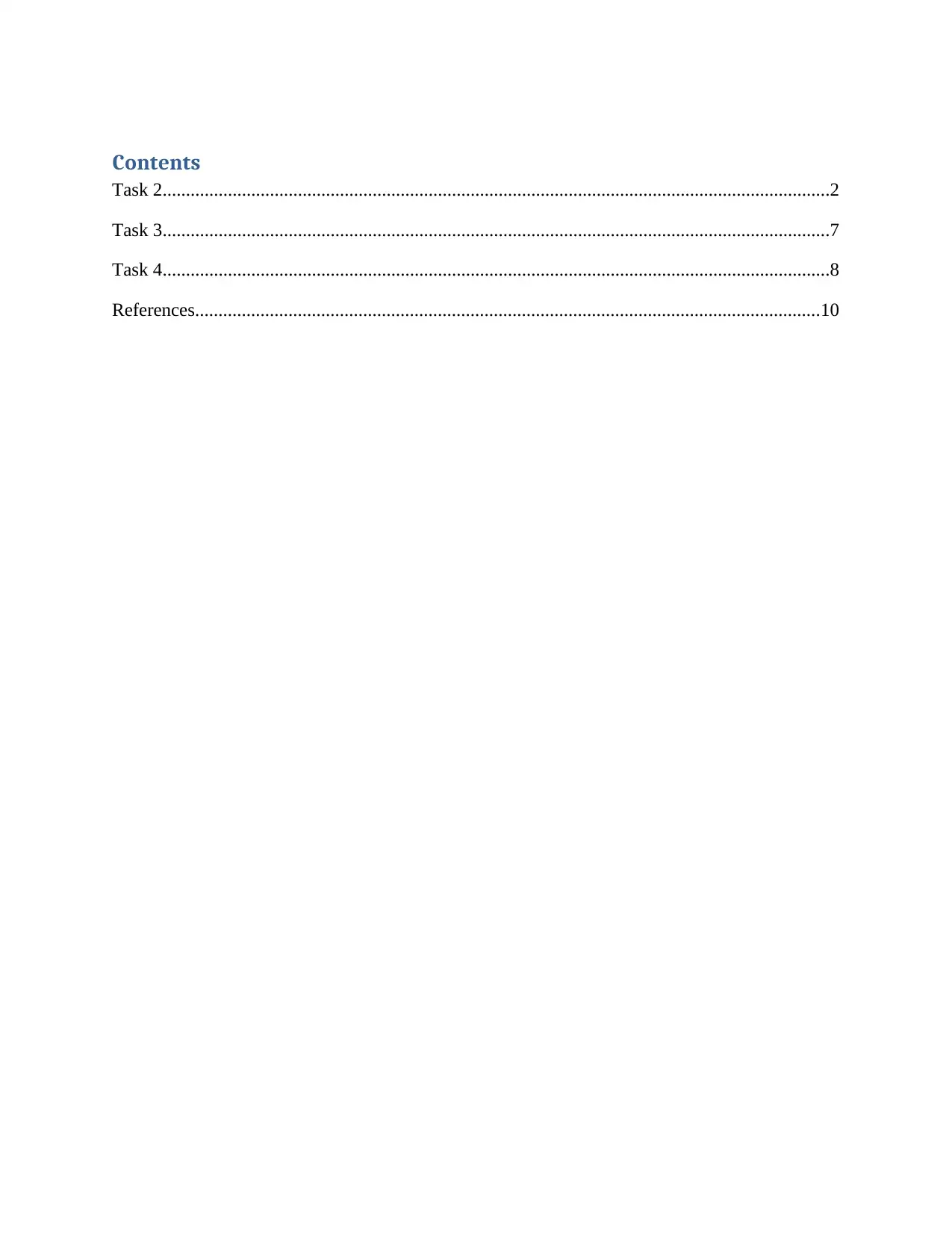
Contents
Task 2...............................................................................................................................................2
Task 3...............................................................................................................................................7
Task 4...............................................................................................................................................8
References......................................................................................................................................10
Task 2...............................................................................................................................................2
Task 3...............................................................................................................................................7
Task 4...............................................................................................................................................8
References......................................................................................................................................10
Paraphrase This Document
Need a fresh take? Get an instant paraphrase of this document with our AI Paraphraser
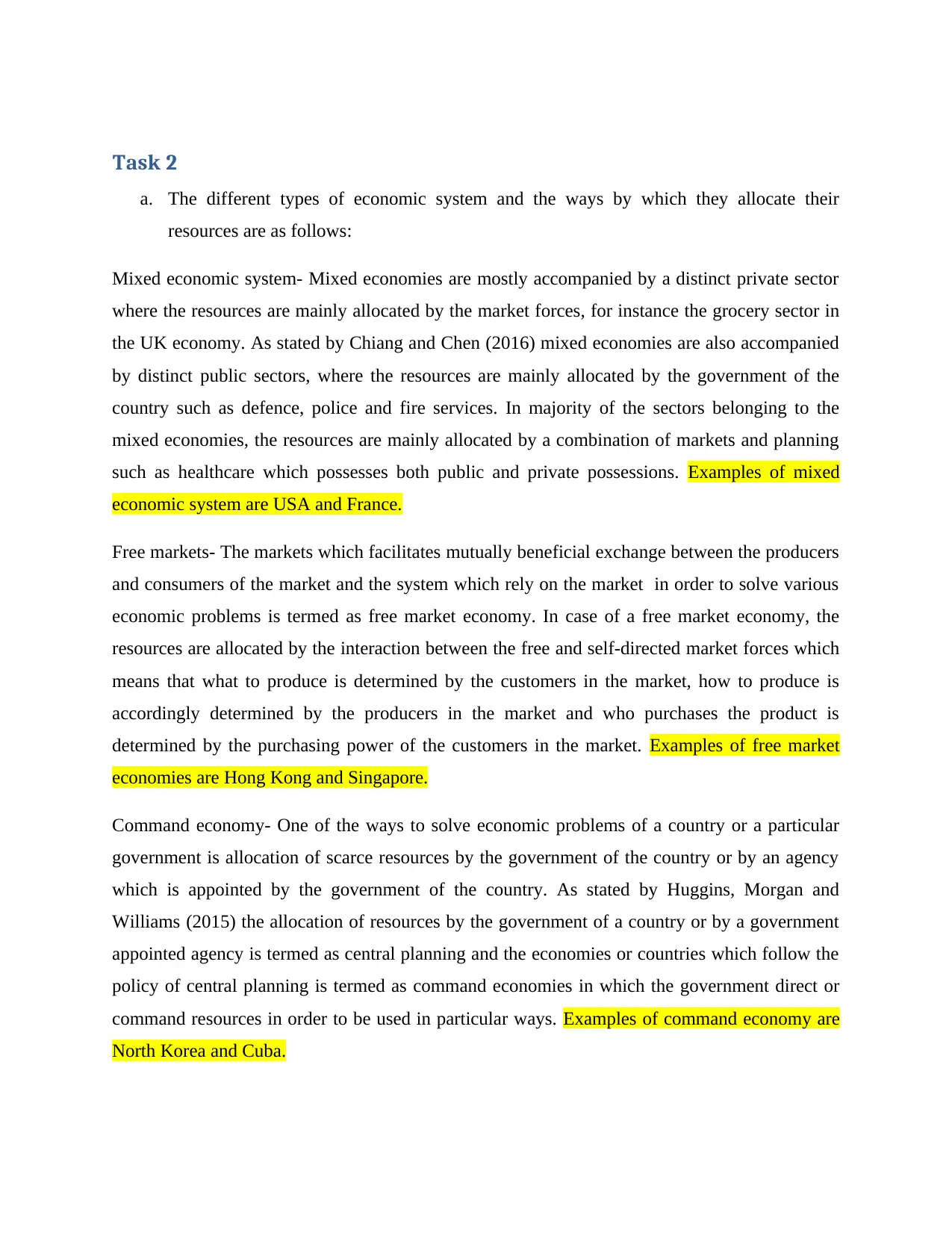
Task 2
a. The different types of economic system and the ways by which they allocate their
resources are as follows:
Mixed economic system- Mixed economies are mostly accompanied by a distinct private sector
where the resources are mainly allocated by the market forces, for instance the grocery sector in
the UK economy. As stated by Chiang and Chen (2016) mixed economies are also accompanied
by distinct public sectors, where the resources are mainly allocated by the government of the
country such as defence, police and fire services. In majority of the sectors belonging to the
mixed economies, the resources are mainly allocated by a combination of markets and planning
such as healthcare which possesses both public and private possessions. Examples of mixed
economic system are USA and France.
Free markets- The markets which facilitates mutually beneficial exchange between the producers
and consumers of the market and the system which rely on the market in order to solve various
economic problems is termed as free market economy. In case of a free market economy, the
resources are allocated by the interaction between the free and self-directed market forces which
means that what to produce is determined by the customers in the market, how to produce is
accordingly determined by the producers in the market and who purchases the product is
determined by the purchasing power of the customers in the market. Examples of free market
economies are Hong Kong and Singapore.
Command economy- One of the ways to solve economic problems of a country or a particular
government is allocation of scarce resources by the government of the country or by an agency
which is appointed by the government of the country. As stated by Huggins, Morgan and
Williams (2015) the allocation of resources by the government of a country or by a government
appointed agency is termed as central planning and the economies or countries which follow the
policy of central planning is termed as command economies in which the government direct or
command resources in order to be used in particular ways. Examples of command economy are
North Korea and Cuba.
a. The different types of economic system and the ways by which they allocate their
resources are as follows:
Mixed economic system- Mixed economies are mostly accompanied by a distinct private sector
where the resources are mainly allocated by the market forces, for instance the grocery sector in
the UK economy. As stated by Chiang and Chen (2016) mixed economies are also accompanied
by distinct public sectors, where the resources are mainly allocated by the government of the
country such as defence, police and fire services. In majority of the sectors belonging to the
mixed economies, the resources are mainly allocated by a combination of markets and planning
such as healthcare which possesses both public and private possessions. Examples of mixed
economic system are USA and France.
Free markets- The markets which facilitates mutually beneficial exchange between the producers
and consumers of the market and the system which rely on the market in order to solve various
economic problems is termed as free market economy. In case of a free market economy, the
resources are allocated by the interaction between the free and self-directed market forces which
means that what to produce is determined by the customers in the market, how to produce is
accordingly determined by the producers in the market and who purchases the product is
determined by the purchasing power of the customers in the market. Examples of free market
economies are Hong Kong and Singapore.
Command economy- One of the ways to solve economic problems of a country or a particular
government is allocation of scarce resources by the government of the country or by an agency
which is appointed by the government of the country. As stated by Huggins, Morgan and
Williams (2015) the allocation of resources by the government of a country or by a government
appointed agency is termed as central planning and the economies or countries which follow the
policy of central planning is termed as command economies in which the government direct or
command resources in order to be used in particular ways. Examples of command economy are
North Korea and Cuba.
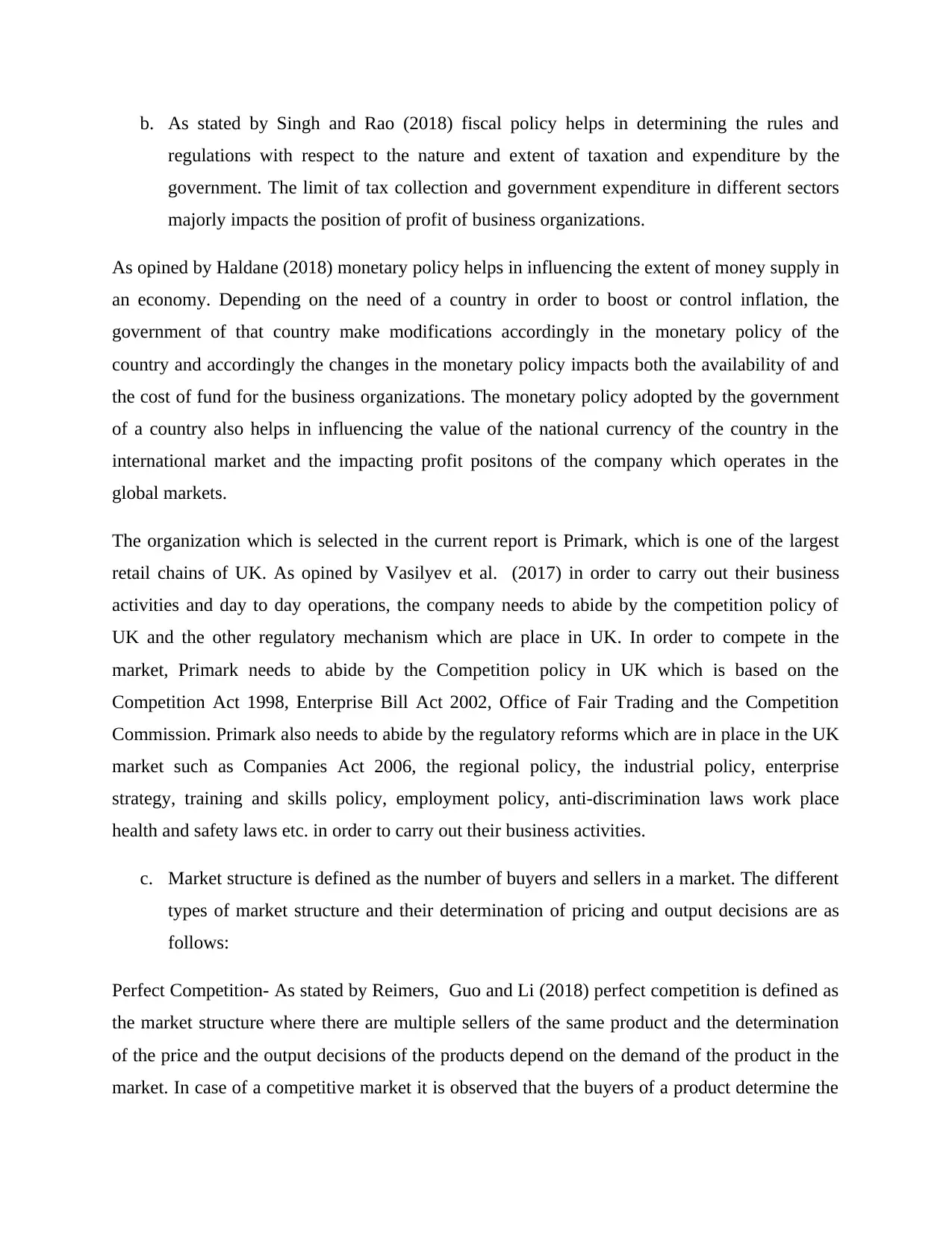
b. As stated by Singh and Rao (2018) fiscal policy helps in determining the rules and
regulations with respect to the nature and extent of taxation and expenditure by the
government. The limit of tax collection and government expenditure in different sectors
majorly impacts the position of profit of business organizations.
As opined by Haldane (2018) monetary policy helps in influencing the extent of money supply in
an economy. Depending on the need of a country in order to boost or control inflation, the
government of that country make modifications accordingly in the monetary policy of the
country and accordingly the changes in the monetary policy impacts both the availability of and
the cost of fund for the business organizations. The monetary policy adopted by the government
of a country also helps in influencing the value of the national currency of the country in the
international market and the impacting profit positons of the company which operates in the
global markets.
The organization which is selected in the current report is Primark, which is one of the largest
retail chains of UK. As opined by Vasilyev et al. (2017) in order to carry out their business
activities and day to day operations, the company needs to abide by the competition policy of
UK and the other regulatory mechanism which are place in UK. In order to compete in the
market, Primark needs to abide by the Competition policy in UK which is based on the
Competition Act 1998, Enterprise Bill Act 2002, Office of Fair Trading and the Competition
Commission. Primark also needs to abide by the regulatory reforms which are in place in the UK
market such as Companies Act 2006, the regional policy, the industrial policy, enterprise
strategy, training and skills policy, employment policy, anti-discrimination laws work place
health and safety laws etc. in order to carry out their business activities.
c. Market structure is defined as the number of buyers and sellers in a market. The different
types of market structure and their determination of pricing and output decisions are as
follows:
Perfect Competition- As stated by Reimers, Guo and Li (2018) perfect competition is defined as
the market structure where there are multiple sellers of the same product and the determination
of the price and the output decisions of the products depend on the demand of the product in the
market. In case of a competitive market it is observed that the buyers of a product determine the
regulations with respect to the nature and extent of taxation and expenditure by the
government. The limit of tax collection and government expenditure in different sectors
majorly impacts the position of profit of business organizations.
As opined by Haldane (2018) monetary policy helps in influencing the extent of money supply in
an economy. Depending on the need of a country in order to boost or control inflation, the
government of that country make modifications accordingly in the monetary policy of the
country and accordingly the changes in the monetary policy impacts both the availability of and
the cost of fund for the business organizations. The monetary policy adopted by the government
of a country also helps in influencing the value of the national currency of the country in the
international market and the impacting profit positons of the company which operates in the
global markets.
The organization which is selected in the current report is Primark, which is one of the largest
retail chains of UK. As opined by Vasilyev et al. (2017) in order to carry out their business
activities and day to day operations, the company needs to abide by the competition policy of
UK and the other regulatory mechanism which are place in UK. In order to compete in the
market, Primark needs to abide by the Competition policy in UK which is based on the
Competition Act 1998, Enterprise Bill Act 2002, Office of Fair Trading and the Competition
Commission. Primark also needs to abide by the regulatory reforms which are in place in the UK
market such as Companies Act 2006, the regional policy, the industrial policy, enterprise
strategy, training and skills policy, employment policy, anti-discrimination laws work place
health and safety laws etc. in order to carry out their business activities.
c. Market structure is defined as the number of buyers and sellers in a market. The different
types of market structure and their determination of pricing and output decisions are as
follows:
Perfect Competition- As stated by Reimers, Guo and Li (2018) perfect competition is defined as
the market structure where there are multiple sellers of the same product and the determination
of the price and the output decisions of the products depend on the demand of the product in the
market. In case of a competitive market it is observed that the buyers of a product determine the
⊘ This is a preview!⊘
Do you want full access?
Subscribe today to unlock all pages.

Trusted by 1+ million students worldwide
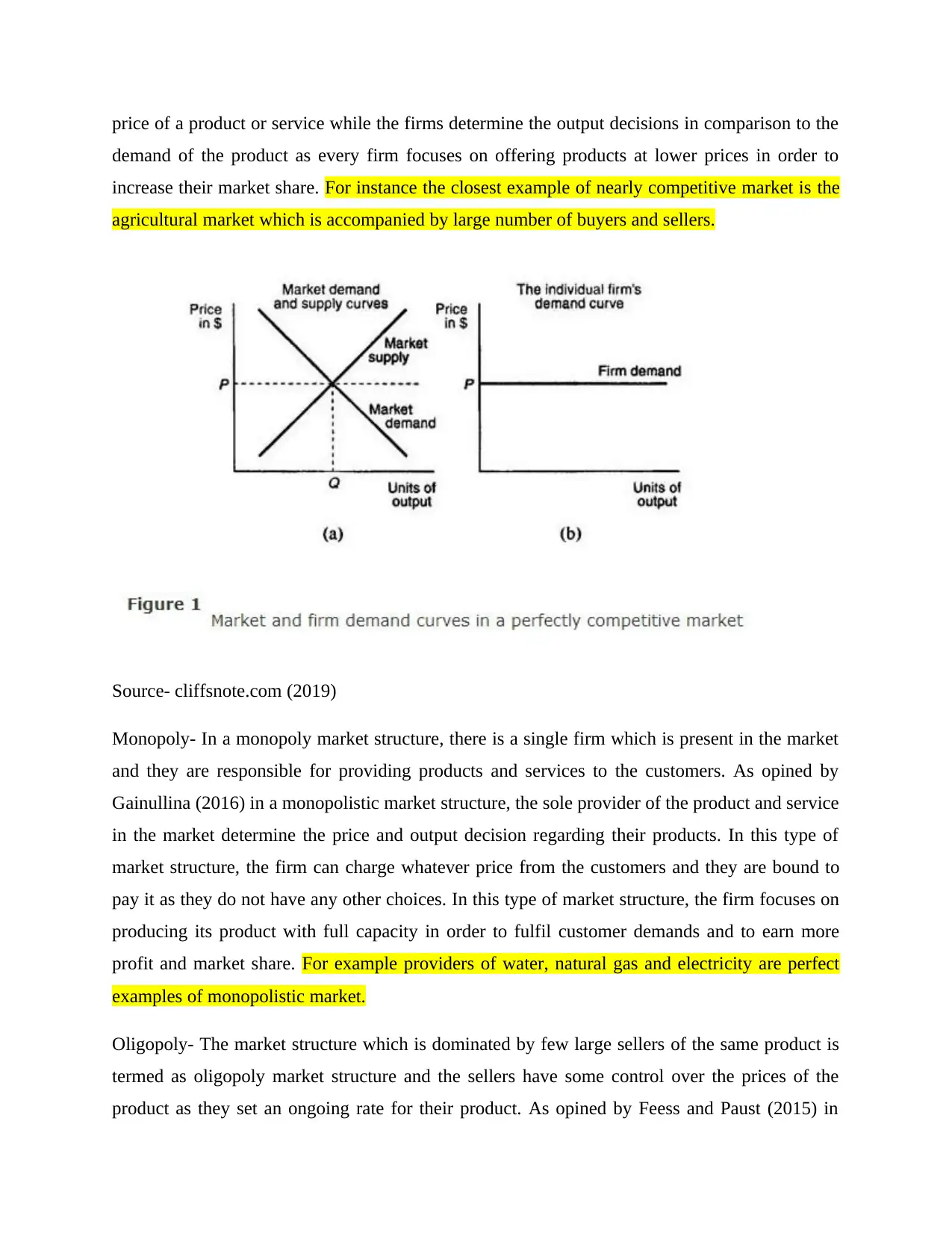
price of a product or service while the firms determine the output decisions in comparison to the
demand of the product as every firm focuses on offering products at lower prices in order to
increase their market share. For instance the closest example of nearly competitive market is the
agricultural market which is accompanied by large number of buyers and sellers.
Source- cliffsnote.com (2019)
Monopoly- In a monopoly market structure, there is a single firm which is present in the market
and they are responsible for providing products and services to the customers. As opined by
Gainullina (2016) in a monopolistic market structure, the sole provider of the product and service
in the market determine the price and output decision regarding their products. In this type of
market structure, the firm can charge whatever price from the customers and they are bound to
pay it as they do not have any other choices. In this type of market structure, the firm focuses on
producing its product with full capacity in order to fulfil customer demands and to earn more
profit and market share. For example providers of water, natural gas and electricity are perfect
examples of monopolistic market.
Oligopoly- The market structure which is dominated by few large sellers of the same product is
termed as oligopoly market structure and the sellers have some control over the prices of the
product as they set an ongoing rate for their product. As opined by Feess and Paust (2015) in
demand of the product as every firm focuses on offering products at lower prices in order to
increase their market share. For instance the closest example of nearly competitive market is the
agricultural market which is accompanied by large number of buyers and sellers.
Source- cliffsnote.com (2019)
Monopoly- In a monopoly market structure, there is a single firm which is present in the market
and they are responsible for providing products and services to the customers. As opined by
Gainullina (2016) in a monopolistic market structure, the sole provider of the product and service
in the market determine the price and output decision regarding their products. In this type of
market structure, the firm can charge whatever price from the customers and they are bound to
pay it as they do not have any other choices. In this type of market structure, the firm focuses on
producing its product with full capacity in order to fulfil customer demands and to earn more
profit and market share. For example providers of water, natural gas and electricity are perfect
examples of monopolistic market.
Oligopoly- The market structure which is dominated by few large sellers of the same product is
termed as oligopoly market structure and the sellers have some control over the prices of the
product as they set an ongoing rate for their product. As opined by Feess and Paust (2015) in
Paraphrase This Document
Need a fresh take? Get an instant paraphrase of this document with our AI Paraphraser
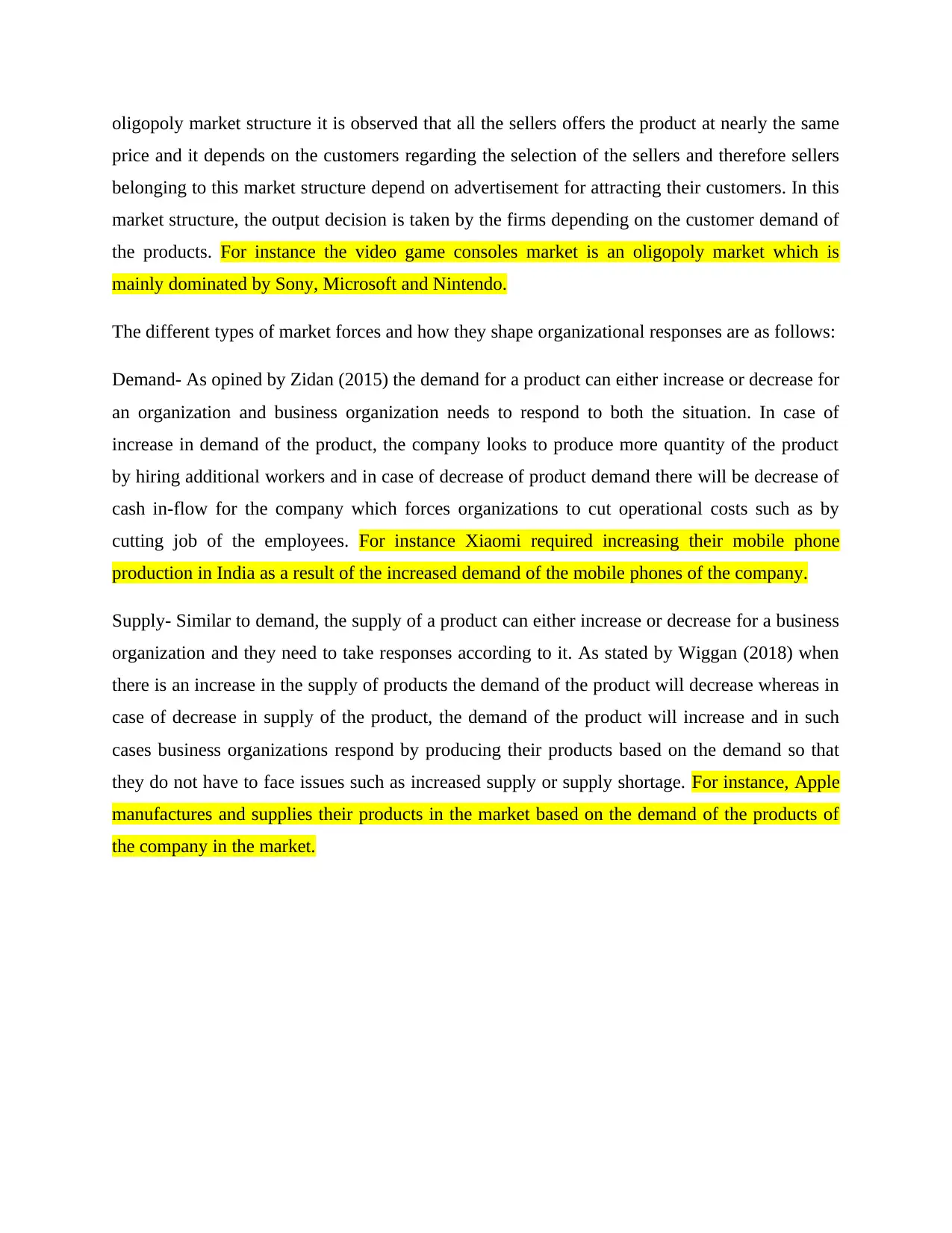
oligopoly market structure it is observed that all the sellers offers the product at nearly the same
price and it depends on the customers regarding the selection of the sellers and therefore sellers
belonging to this market structure depend on advertisement for attracting their customers. In this
market structure, the output decision is taken by the firms depending on the customer demand of
the products. For instance the video game consoles market is an oligopoly market which is
mainly dominated by Sony, Microsoft and Nintendo.
The different types of market forces and how they shape organizational responses are as follows:
Demand- As opined by Zidan (2015) the demand for a product can either increase or decrease for
an organization and business organization needs to respond to both the situation. In case of
increase in demand of the product, the company looks to produce more quantity of the product
by hiring additional workers and in case of decrease of product demand there will be decrease of
cash in-flow for the company which forces organizations to cut operational costs such as by
cutting job of the employees. For instance Xiaomi required increasing their mobile phone
production in India as a result of the increased demand of the mobile phones of the company.
Supply- Similar to demand, the supply of a product can either increase or decrease for a business
organization and they need to take responses according to it. As stated by Wiggan (2018) when
there is an increase in the supply of products the demand of the product will decrease whereas in
case of decrease in supply of the product, the demand of the product will increase and in such
cases business organizations respond by producing their products based on the demand so that
they do not have to face issues such as increased supply or supply shortage. For instance, Apple
manufactures and supplies their products in the market based on the demand of the products of
the company in the market.
price and it depends on the customers regarding the selection of the sellers and therefore sellers
belonging to this market structure depend on advertisement for attracting their customers. In this
market structure, the output decision is taken by the firms depending on the customer demand of
the products. For instance the video game consoles market is an oligopoly market which is
mainly dominated by Sony, Microsoft and Nintendo.
The different types of market forces and how they shape organizational responses are as follows:
Demand- As opined by Zidan (2015) the demand for a product can either increase or decrease for
an organization and business organization needs to respond to both the situation. In case of
increase in demand of the product, the company looks to produce more quantity of the product
by hiring additional workers and in case of decrease of product demand there will be decrease of
cash in-flow for the company which forces organizations to cut operational costs such as by
cutting job of the employees. For instance Xiaomi required increasing their mobile phone
production in India as a result of the increased demand of the mobile phones of the company.
Supply- Similar to demand, the supply of a product can either increase or decrease for a business
organization and they need to take responses according to it. As stated by Wiggan (2018) when
there is an increase in the supply of products the demand of the product will decrease whereas in
case of decrease in supply of the product, the demand of the product will increase and in such
cases business organizations respond by producing their products based on the demand so that
they do not have to face issues such as increased supply or supply shortage. For instance, Apple
manufactures and supplies their products in the market based on the demand of the products of
the company in the market.
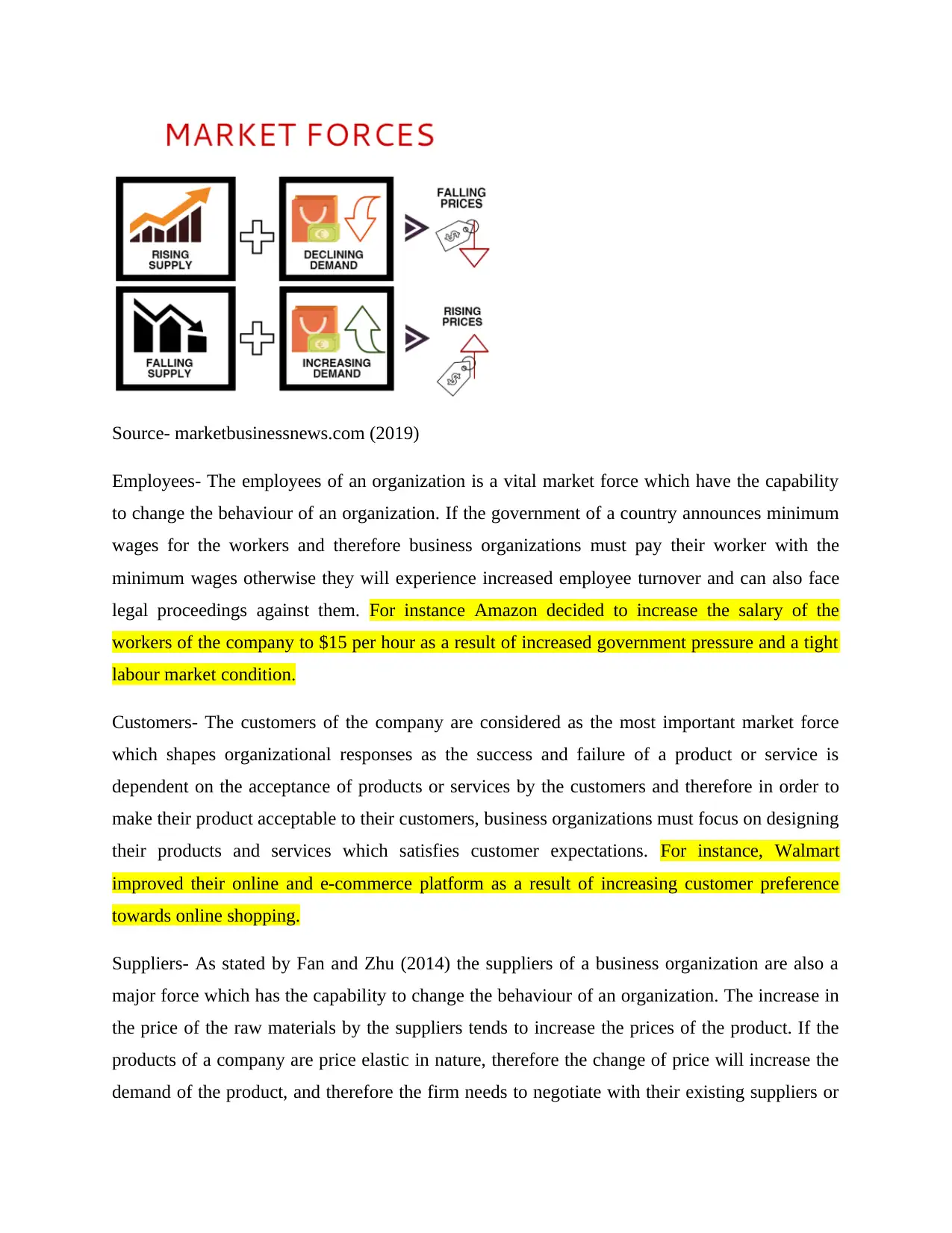
Source- marketbusinessnews.com (2019)
Employees- The employees of an organization is a vital market force which have the capability
to change the behaviour of an organization. If the government of a country announces minimum
wages for the workers and therefore business organizations must pay their worker with the
minimum wages otherwise they will experience increased employee turnover and can also face
legal proceedings against them. For instance Amazon decided to increase the salary of the
workers of the company to $15 per hour as a result of increased government pressure and a tight
labour market condition.
Customers- The customers of the company are considered as the most important market force
which shapes organizational responses as the success and failure of a product or service is
dependent on the acceptance of products or services by the customers and therefore in order to
make their product acceptable to their customers, business organizations must focus on designing
their products and services which satisfies customer expectations. For instance, Walmart
improved their online and e-commerce platform as a result of increasing customer preference
towards online shopping.
Suppliers- As stated by Fan and Zhu (2014) the suppliers of a business organization are also a
major force which has the capability to change the behaviour of an organization. The increase in
the price of the raw materials by the suppliers tends to increase the prices of the product. If the
products of a company are price elastic in nature, therefore the change of price will increase the
demand of the product, and therefore the firm needs to negotiate with their existing suppliers or
Employees- The employees of an organization is a vital market force which have the capability
to change the behaviour of an organization. If the government of a country announces minimum
wages for the workers and therefore business organizations must pay their worker with the
minimum wages otherwise they will experience increased employee turnover and can also face
legal proceedings against them. For instance Amazon decided to increase the salary of the
workers of the company to $15 per hour as a result of increased government pressure and a tight
labour market condition.
Customers- The customers of the company are considered as the most important market force
which shapes organizational responses as the success and failure of a product or service is
dependent on the acceptance of products or services by the customers and therefore in order to
make their product acceptable to their customers, business organizations must focus on designing
their products and services which satisfies customer expectations. For instance, Walmart
improved their online and e-commerce platform as a result of increasing customer preference
towards online shopping.
Suppliers- As stated by Fan and Zhu (2014) the suppliers of a business organization are also a
major force which has the capability to change the behaviour of an organization. The increase in
the price of the raw materials by the suppliers tends to increase the prices of the product. If the
products of a company are price elastic in nature, therefore the change of price will increase the
demand of the product, and therefore the firm needs to negotiate with their existing suppliers or
⊘ This is a preview!⊘
Do you want full access?
Subscribe today to unlock all pages.

Trusted by 1+ million students worldwide
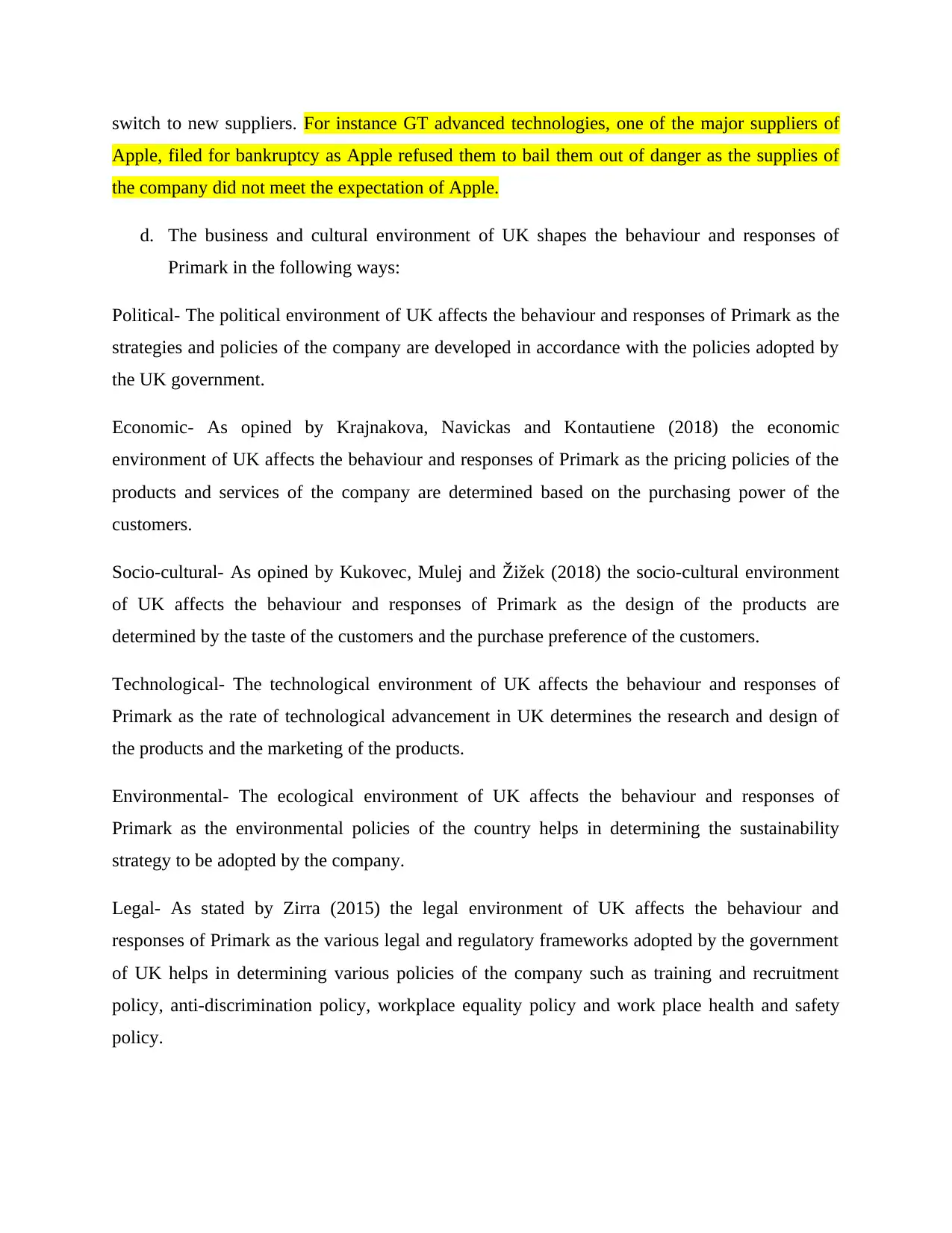
switch to new suppliers. For instance GT advanced technologies, one of the major suppliers of
Apple, filed for bankruptcy as Apple refused them to bail them out of danger as the supplies of
the company did not meet the expectation of Apple.
d. The business and cultural environment of UK shapes the behaviour and responses of
Primark in the following ways:
Political- The political environment of UK affects the behaviour and responses of Primark as the
strategies and policies of the company are developed in accordance with the policies adopted by
the UK government.
Economic- As opined by Krajnakova, Navickas and Kontautiene (2018) the economic
environment of UK affects the behaviour and responses of Primark as the pricing policies of the
products and services of the company are determined based on the purchasing power of the
customers.
Socio-cultural- As opined by Kukovec, Mulej and Žižek (2018) the socio-cultural environment
of UK affects the behaviour and responses of Primark as the design of the products are
determined by the taste of the customers and the purchase preference of the customers.
Technological- The technological environment of UK affects the behaviour and responses of
Primark as the rate of technological advancement in UK determines the research and design of
the products and the marketing of the products.
Environmental- The ecological environment of UK affects the behaviour and responses of
Primark as the environmental policies of the country helps in determining the sustainability
strategy to be adopted by the company.
Legal- As stated by Zirra (2015) the legal environment of UK affects the behaviour and
responses of Primark as the various legal and regulatory frameworks adopted by the government
of UK helps in determining various policies of the company such as training and recruitment
policy, anti-discrimination policy, workplace equality policy and work place health and safety
policy.
Apple, filed for bankruptcy as Apple refused them to bail them out of danger as the supplies of
the company did not meet the expectation of Apple.
d. The business and cultural environment of UK shapes the behaviour and responses of
Primark in the following ways:
Political- The political environment of UK affects the behaviour and responses of Primark as the
strategies and policies of the company are developed in accordance with the policies adopted by
the UK government.
Economic- As opined by Krajnakova, Navickas and Kontautiene (2018) the economic
environment of UK affects the behaviour and responses of Primark as the pricing policies of the
products and services of the company are determined based on the purchasing power of the
customers.
Socio-cultural- As opined by Kukovec, Mulej and Žižek (2018) the socio-cultural environment
of UK affects the behaviour and responses of Primark as the design of the products are
determined by the taste of the customers and the purchase preference of the customers.
Technological- The technological environment of UK affects the behaviour and responses of
Primark as the rate of technological advancement in UK determines the research and design of
the products and the marketing of the products.
Environmental- The ecological environment of UK affects the behaviour and responses of
Primark as the environmental policies of the country helps in determining the sustainability
strategy to be adopted by the company.
Legal- As stated by Zirra (2015) the legal environment of UK affects the behaviour and
responses of Primark as the various legal and regulatory frameworks adopted by the government
of UK helps in determining various policies of the company such as training and recruitment
policy, anti-discrimination policy, workplace equality policy and work place health and safety
policy.
Paraphrase This Document
Need a fresh take? Get an instant paraphrase of this document with our AI Paraphraser
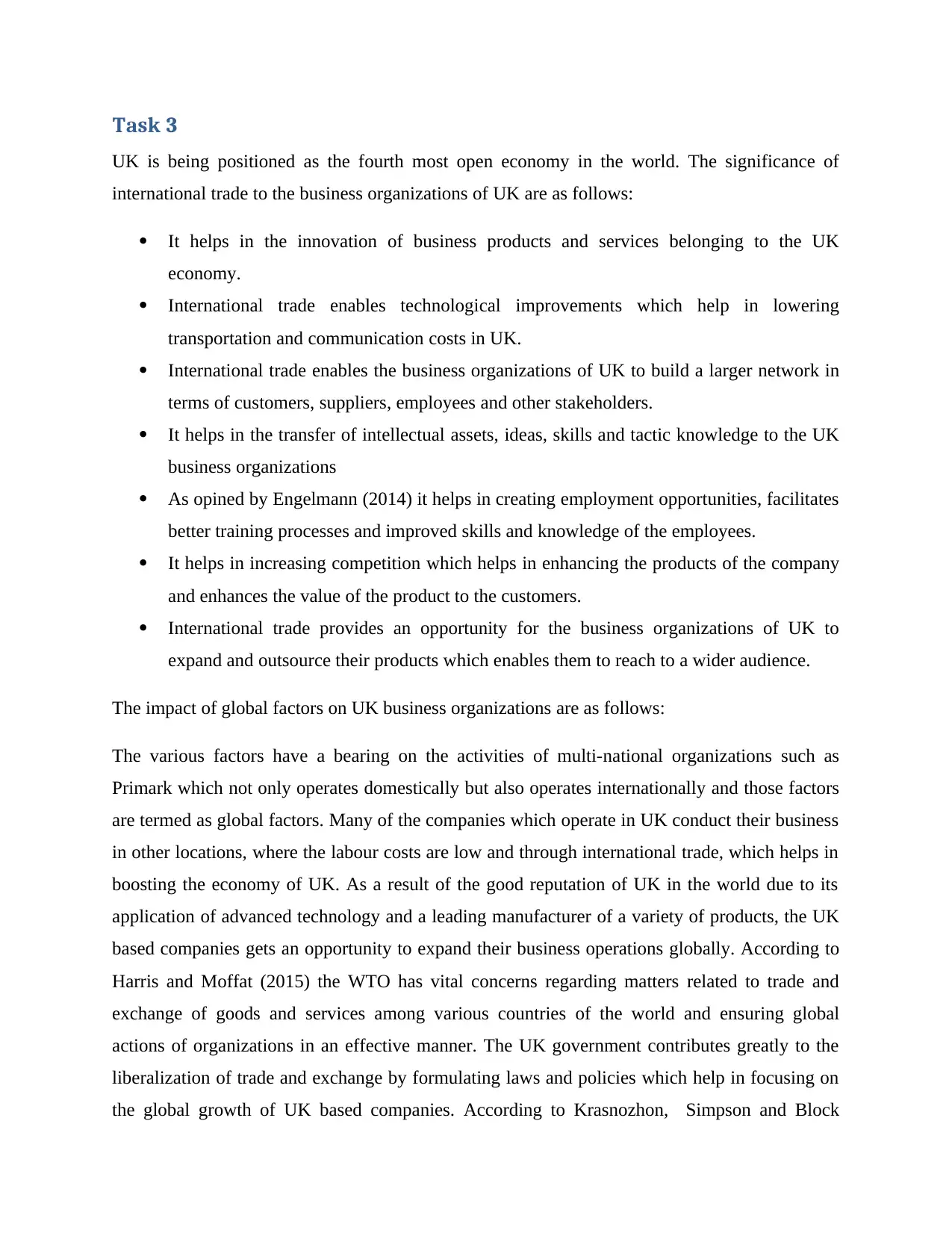
Task 3
UK is being positioned as the fourth most open economy in the world. The significance of
international trade to the business organizations of UK are as follows:
It helps in the innovation of business products and services belonging to the UK
economy.
International trade enables technological improvements which help in lowering
transportation and communication costs in UK.
International trade enables the business organizations of UK to build a larger network in
terms of customers, suppliers, employees and other stakeholders.
It helps in the transfer of intellectual assets, ideas, skills and tactic knowledge to the UK
business organizations
As opined by Engelmann (2014) it helps in creating employment opportunities, facilitates
better training processes and improved skills and knowledge of the employees.
It helps in increasing competition which helps in enhancing the products of the company
and enhances the value of the product to the customers.
International trade provides an opportunity for the business organizations of UK to
expand and outsource their products which enables them to reach to a wider audience.
The impact of global factors on UK business organizations are as follows:
The various factors have a bearing on the activities of multi-national organizations such as
Primark which not only operates domestically but also operates internationally and those factors
are termed as global factors. Many of the companies which operate in UK conduct their business
in other locations, where the labour costs are low and through international trade, which helps in
boosting the economy of UK. As a result of the good reputation of UK in the world due to its
application of advanced technology and a leading manufacturer of a variety of products, the UK
based companies gets an opportunity to expand their business operations globally. According to
Harris and Moffat (2015) the WTO has vital concerns regarding matters related to trade and
exchange of goods and services among various countries of the world and ensuring global
actions of organizations in an effective manner. The UK government contributes greatly to the
liberalization of trade and exchange by formulating laws and policies which help in focusing on
the global growth of UK based companies. According to Krasnozhon, Simpson and Block
UK is being positioned as the fourth most open economy in the world. The significance of
international trade to the business organizations of UK are as follows:
It helps in the innovation of business products and services belonging to the UK
economy.
International trade enables technological improvements which help in lowering
transportation and communication costs in UK.
International trade enables the business organizations of UK to build a larger network in
terms of customers, suppliers, employees and other stakeholders.
It helps in the transfer of intellectual assets, ideas, skills and tactic knowledge to the UK
business organizations
As opined by Engelmann (2014) it helps in creating employment opportunities, facilitates
better training processes and improved skills and knowledge of the employees.
It helps in increasing competition which helps in enhancing the products of the company
and enhances the value of the product to the customers.
International trade provides an opportunity for the business organizations of UK to
expand and outsource their products which enables them to reach to a wider audience.
The impact of global factors on UK business organizations are as follows:
The various factors have a bearing on the activities of multi-national organizations such as
Primark which not only operates domestically but also operates internationally and those factors
are termed as global factors. Many of the companies which operate in UK conduct their business
in other locations, where the labour costs are low and through international trade, which helps in
boosting the economy of UK. As a result of the good reputation of UK in the world due to its
application of advanced technology and a leading manufacturer of a variety of products, the UK
based companies gets an opportunity to expand their business operations globally. According to
Harris and Moffat (2015) the WTO has vital concerns regarding matters related to trade and
exchange of goods and services among various countries of the world and ensuring global
actions of organizations in an effective manner. The UK government contributes greatly to the
liberalization of trade and exchange by formulating laws and policies which help in focusing on
the global growth of UK based companies. According to Krasnozhon, Simpson and Block
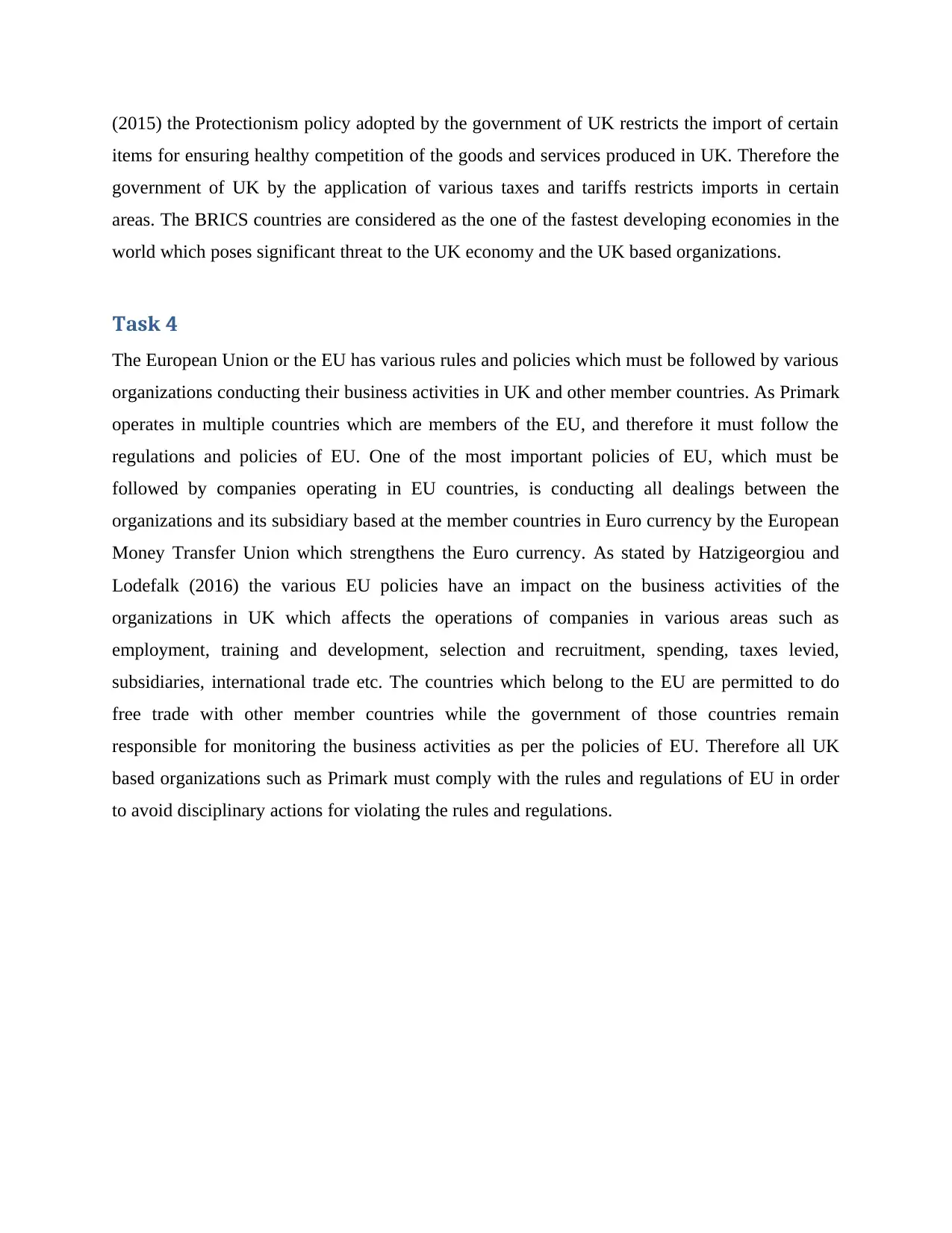
(2015) the Protectionism policy adopted by the government of UK restricts the import of certain
items for ensuring healthy competition of the goods and services produced in UK. Therefore the
government of UK by the application of various taxes and tariffs restricts imports in certain
areas. The BRICS countries are considered as the one of the fastest developing economies in the
world which poses significant threat to the UK economy and the UK based organizations.
Task 4
The European Union or the EU has various rules and policies which must be followed by various
organizations conducting their business activities in UK and other member countries. As Primark
operates in multiple countries which are members of the EU, and therefore it must follow the
regulations and policies of EU. One of the most important policies of EU, which must be
followed by companies operating in EU countries, is conducting all dealings between the
organizations and its subsidiary based at the member countries in Euro currency by the European
Money Transfer Union which strengthens the Euro currency. As stated by Hatzigeorgiou and
Lodefalk (2016) the various EU policies have an impact on the business activities of the
organizations in UK which affects the operations of companies in various areas such as
employment, training and development, selection and recruitment, spending, taxes levied,
subsidiaries, international trade etc. The countries which belong to the EU are permitted to do
free trade with other member countries while the government of those countries remain
responsible for monitoring the business activities as per the policies of EU. Therefore all UK
based organizations such as Primark must comply with the rules and regulations of EU in order
to avoid disciplinary actions for violating the rules and regulations.
items for ensuring healthy competition of the goods and services produced in UK. Therefore the
government of UK by the application of various taxes and tariffs restricts imports in certain
areas. The BRICS countries are considered as the one of the fastest developing economies in the
world which poses significant threat to the UK economy and the UK based organizations.
Task 4
The European Union or the EU has various rules and policies which must be followed by various
organizations conducting their business activities in UK and other member countries. As Primark
operates in multiple countries which are members of the EU, and therefore it must follow the
regulations and policies of EU. One of the most important policies of EU, which must be
followed by companies operating in EU countries, is conducting all dealings between the
organizations and its subsidiary based at the member countries in Euro currency by the European
Money Transfer Union which strengthens the Euro currency. As stated by Hatzigeorgiou and
Lodefalk (2016) the various EU policies have an impact on the business activities of the
organizations in UK which affects the operations of companies in various areas such as
employment, training and development, selection and recruitment, spending, taxes levied,
subsidiaries, international trade etc. The countries which belong to the EU are permitted to do
free trade with other member countries while the government of those countries remain
responsible for monitoring the business activities as per the policies of EU. Therefore all UK
based organizations such as Primark must comply with the rules and regulations of EU in order
to avoid disciplinary actions for violating the rules and regulations.
⊘ This is a preview!⊘
Do you want full access?
Subscribe today to unlock all pages.

Trusted by 1+ million students worldwide
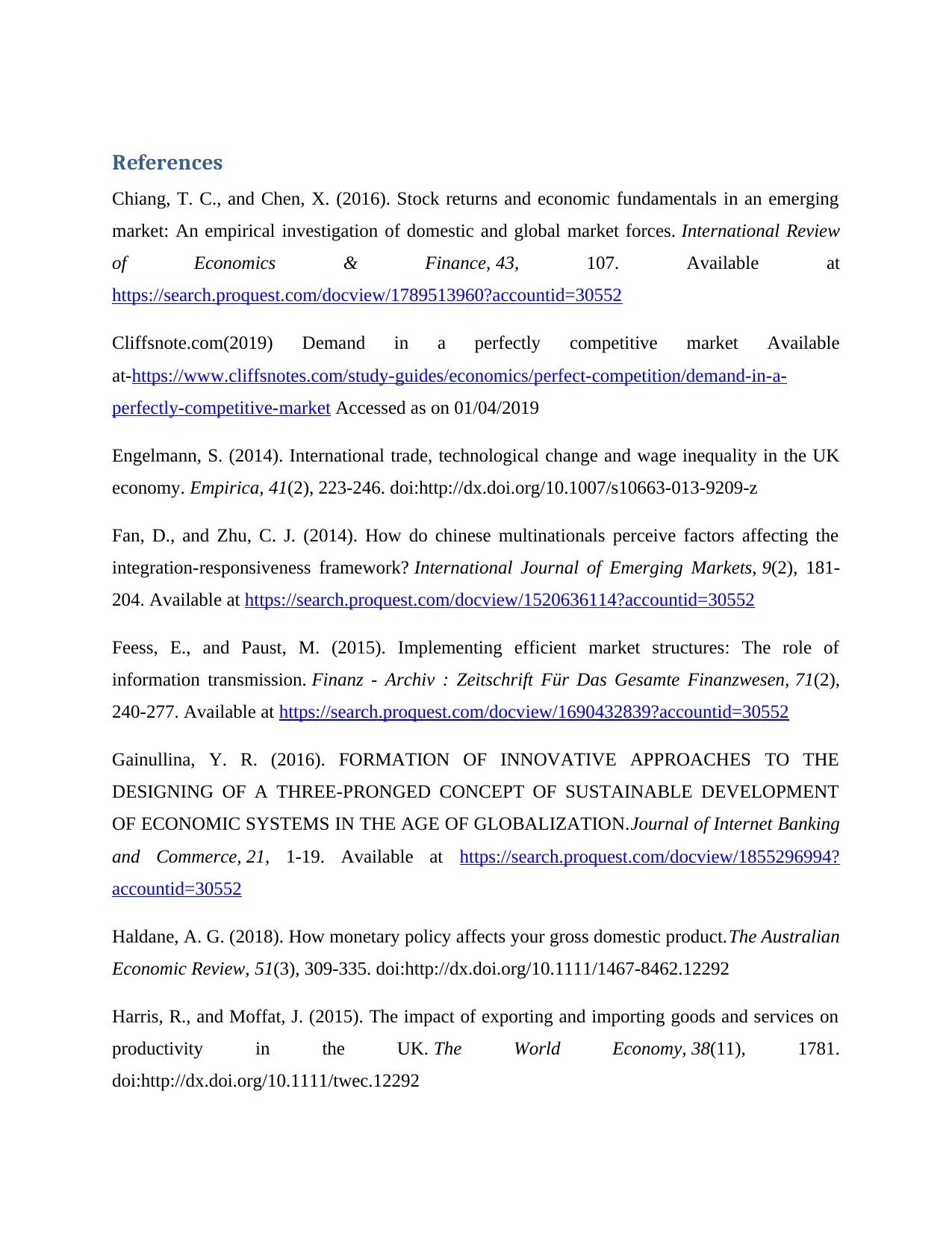
References
Chiang, T. C., and Chen, X. (2016). Stock returns and economic fundamentals in an emerging
market: An empirical investigation of domestic and global market forces. International Review
of Economics & Finance, 43, 107. Available at
https://search.proquest.com/docview/1789513960?accountid=30552
Cliffsnote.com(2019) Demand in a perfectly competitive market Available
at-https://www.cliffsnotes.com/study-guides/economics/perfect-competition/demand-in-a-
perfectly-competitive-market Accessed as on 01/04/2019
Engelmann, S. (2014). International trade, technological change and wage inequality in the UK
economy. Empirica, 41(2), 223-246. doi:http://dx.doi.org/10.1007/s10663-013-9209-z
Fan, D., and Zhu, C. J. (2014). How do chinese multinationals perceive factors affecting the
integration-responsiveness framework? International Journal of Emerging Markets, 9(2), 181-
204. Available at https://search.proquest.com/docview/1520636114?accountid=30552
Feess, E., and Paust, M. (2015). Implementing efficient market structures: The role of
information transmission. Finanz - Archiv : Zeitschrift Für Das Gesamte Finanzwesen, 71(2),
240-277. Available at https://search.proquest.com/docview/1690432839?accountid=30552
Gainullina, Y. R. (2016). FORMATION OF INNOVATIVE APPROACHES TO THE
DESIGNING OF A THREE-PRONGED CONCEPT OF SUSTAINABLE DEVELOPMENT
OF ECONOMIC SYSTEMS IN THE AGE OF GLOBALIZATION.Journal of Internet Banking
and Commerce, 21, 1-19. Available at https://search.proquest.com/docview/1855296994?
accountid=30552
Haldane, A. G. (2018). How monetary policy affects your gross domestic product.The Australian
Economic Review, 51(3), 309-335. doi:http://dx.doi.org/10.1111/1467-8462.12292
Harris, R., and Moffat, J. (2015). The impact of exporting and importing goods and services on
productivity in the UK. The World Economy, 38(11), 1781.
doi:http://dx.doi.org/10.1111/twec.12292
Chiang, T. C., and Chen, X. (2016). Stock returns and economic fundamentals in an emerging
market: An empirical investigation of domestic and global market forces. International Review
of Economics & Finance, 43, 107. Available at
https://search.proquest.com/docview/1789513960?accountid=30552
Cliffsnote.com(2019) Demand in a perfectly competitive market Available
at-https://www.cliffsnotes.com/study-guides/economics/perfect-competition/demand-in-a-
perfectly-competitive-market Accessed as on 01/04/2019
Engelmann, S. (2014). International trade, technological change and wage inequality in the UK
economy. Empirica, 41(2), 223-246. doi:http://dx.doi.org/10.1007/s10663-013-9209-z
Fan, D., and Zhu, C. J. (2014). How do chinese multinationals perceive factors affecting the
integration-responsiveness framework? International Journal of Emerging Markets, 9(2), 181-
204. Available at https://search.proquest.com/docview/1520636114?accountid=30552
Feess, E., and Paust, M. (2015). Implementing efficient market structures: The role of
information transmission. Finanz - Archiv : Zeitschrift Für Das Gesamte Finanzwesen, 71(2),
240-277. Available at https://search.proquest.com/docview/1690432839?accountid=30552
Gainullina, Y. R. (2016). FORMATION OF INNOVATIVE APPROACHES TO THE
DESIGNING OF A THREE-PRONGED CONCEPT OF SUSTAINABLE DEVELOPMENT
OF ECONOMIC SYSTEMS IN THE AGE OF GLOBALIZATION.Journal of Internet Banking
and Commerce, 21, 1-19. Available at https://search.proquest.com/docview/1855296994?
accountid=30552
Haldane, A. G. (2018). How monetary policy affects your gross domestic product.The Australian
Economic Review, 51(3), 309-335. doi:http://dx.doi.org/10.1111/1467-8462.12292
Harris, R., and Moffat, J. (2015). The impact of exporting and importing goods and services on
productivity in the UK. The World Economy, 38(11), 1781.
doi:http://dx.doi.org/10.1111/twec.12292
Paraphrase This Document
Need a fresh take? Get an instant paraphrase of this document with our AI Paraphraser
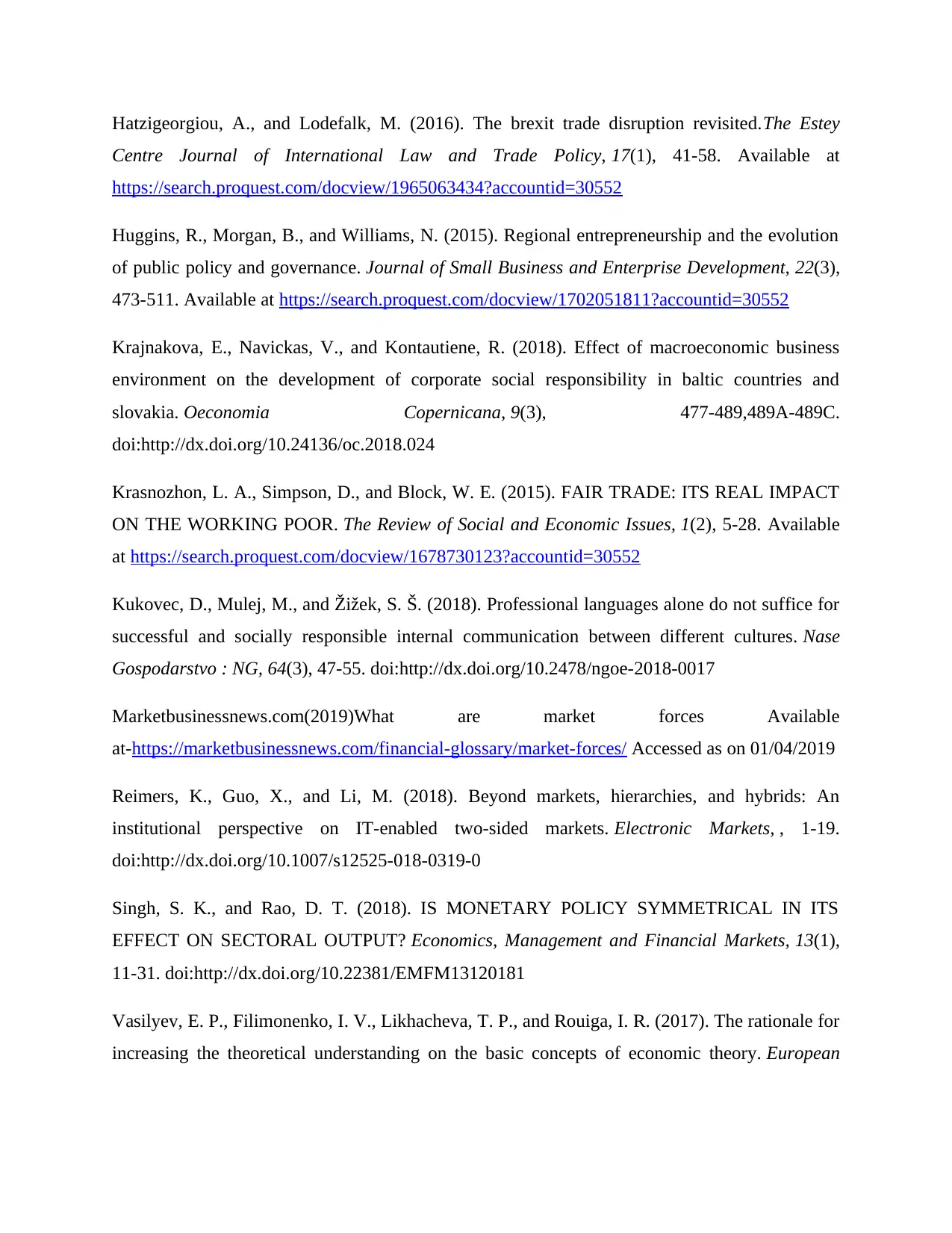
Hatzigeorgiou, A., and Lodefalk, M. (2016). The brexit trade disruption revisited.The Estey
Centre Journal of International Law and Trade Policy, 17(1), 41-58. Available at
https://search.proquest.com/docview/1965063434?accountid=30552
Huggins, R., Morgan, B., and Williams, N. (2015). Regional entrepreneurship and the evolution
of public policy and governance. Journal of Small Business and Enterprise Development, 22(3),
473-511. Available at https://search.proquest.com/docview/1702051811?accountid=30552
Krajnakova, E., Navickas, V., and Kontautiene, R. (2018). Effect of macroeconomic business
environment on the development of corporate social responsibility in baltic countries and
slovakia. Oeconomia Copernicana, 9(3), 477-489,489A-489C.
doi:http://dx.doi.org/10.24136/oc.2018.024
Krasnozhon, L. A., Simpson, D., and Block, W. E. (2015). FAIR TRADE: ITS REAL IMPACT
ON THE WORKING POOR. The Review of Social and Economic Issues, 1(2), 5-28. Available
at https://search.proquest.com/docview/1678730123?accountid=30552
Kukovec, D., Mulej, M., and Žižek, S. Š. (2018). Professional languages alone do not suffice for
successful and socially responsible internal communication between different cultures. Nase
Gospodarstvo : NG, 64(3), 47-55. doi:http://dx.doi.org/10.2478/ngoe-2018-0017
Marketbusinessnews.com(2019)What are market forces Available
at-https://marketbusinessnews.com/financial-glossary/market-forces/ Accessed as on 01/04/2019
Reimers, K., Guo, X., and Li, M. (2018). Beyond markets, hierarchies, and hybrids: An
institutional perspective on IT-enabled two-sided markets. Electronic Markets, , 1-19.
doi:http://dx.doi.org/10.1007/s12525-018-0319-0
Singh, S. K., and Rao, D. T. (2018). IS MONETARY POLICY SYMMETRICAL IN ITS
EFFECT ON SECTORAL OUTPUT? Economics, Management and Financial Markets, 13(1),
11-31. doi:http://dx.doi.org/10.22381/EMFM13120181
Vasilyev, E. P., Filimonenko, I. V., Likhacheva, T. P., and Rouiga, I. R. (2017). The rationale for
increasing the theoretical understanding on the basic concepts of economic theory. European
Centre Journal of International Law and Trade Policy, 17(1), 41-58. Available at
https://search.proquest.com/docview/1965063434?accountid=30552
Huggins, R., Morgan, B., and Williams, N. (2015). Regional entrepreneurship and the evolution
of public policy and governance. Journal of Small Business and Enterprise Development, 22(3),
473-511. Available at https://search.proquest.com/docview/1702051811?accountid=30552
Krajnakova, E., Navickas, V., and Kontautiene, R. (2018). Effect of macroeconomic business
environment on the development of corporate social responsibility in baltic countries and
slovakia. Oeconomia Copernicana, 9(3), 477-489,489A-489C.
doi:http://dx.doi.org/10.24136/oc.2018.024
Krasnozhon, L. A., Simpson, D., and Block, W. E. (2015). FAIR TRADE: ITS REAL IMPACT
ON THE WORKING POOR. The Review of Social and Economic Issues, 1(2), 5-28. Available
at https://search.proquest.com/docview/1678730123?accountid=30552
Kukovec, D., Mulej, M., and Žižek, S. Š. (2018). Professional languages alone do not suffice for
successful and socially responsible internal communication between different cultures. Nase
Gospodarstvo : NG, 64(3), 47-55. doi:http://dx.doi.org/10.2478/ngoe-2018-0017
Marketbusinessnews.com(2019)What are market forces Available
at-https://marketbusinessnews.com/financial-glossary/market-forces/ Accessed as on 01/04/2019
Reimers, K., Guo, X., and Li, M. (2018). Beyond markets, hierarchies, and hybrids: An
institutional perspective on IT-enabled two-sided markets. Electronic Markets, , 1-19.
doi:http://dx.doi.org/10.1007/s12525-018-0319-0
Singh, S. K., and Rao, D. T. (2018). IS MONETARY POLICY SYMMETRICAL IN ITS
EFFECT ON SECTORAL OUTPUT? Economics, Management and Financial Markets, 13(1),
11-31. doi:http://dx.doi.org/10.22381/EMFM13120181
Vasilyev, E. P., Filimonenko, I. V., Likhacheva, T. P., and Rouiga, I. R. (2017). The rationale for
increasing the theoretical understanding on the basic concepts of economic theory. European
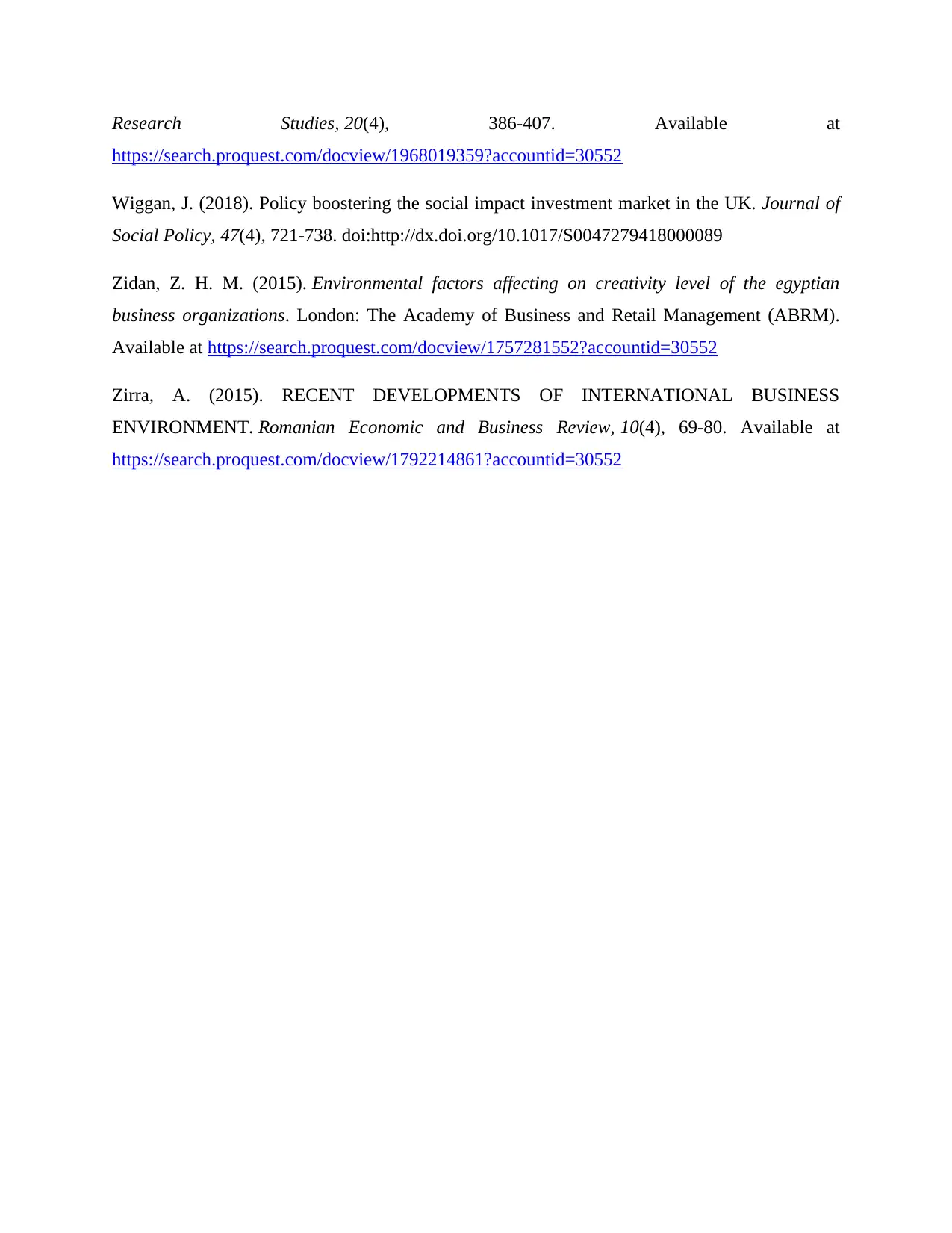
Research Studies, 20(4), 386-407. Available at
https://search.proquest.com/docview/1968019359?accountid=30552
Wiggan, J. (2018). Policy boostering the social impact investment market in the UK. Journal of
Social Policy, 47(4), 721-738. doi:http://dx.doi.org/10.1017/S0047279418000089
Zidan, Z. H. M. (2015). Environmental factors affecting on creativity level of the egyptian
business organizations. London: The Academy of Business and Retail Management (ABRM).
Available at https://search.proquest.com/docview/1757281552?accountid=30552
Zirra, A. (2015). RECENT DEVELOPMENTS OF INTERNATIONAL BUSINESS
ENVIRONMENT. Romanian Economic and Business Review, 10(4), 69-80. Available at
https://search.proquest.com/docview/1792214861?accountid=30552
https://search.proquest.com/docview/1968019359?accountid=30552
Wiggan, J. (2018). Policy boostering the social impact investment market in the UK. Journal of
Social Policy, 47(4), 721-738. doi:http://dx.doi.org/10.1017/S0047279418000089
Zidan, Z. H. M. (2015). Environmental factors affecting on creativity level of the egyptian
business organizations. London: The Academy of Business and Retail Management (ABRM).
Available at https://search.proquest.com/docview/1757281552?accountid=30552
Zirra, A. (2015). RECENT DEVELOPMENTS OF INTERNATIONAL BUSINESS
ENVIRONMENT. Romanian Economic and Business Review, 10(4), 69-80. Available at
https://search.proquest.com/docview/1792214861?accountid=30552
⊘ This is a preview!⊘
Do you want full access?
Subscribe today to unlock all pages.

Trusted by 1+ million students worldwide
1 out of 12
Related Documents
Your All-in-One AI-Powered Toolkit for Academic Success.
+13062052269
info@desklib.com
Available 24*7 on WhatsApp / Email
![[object Object]](/_next/static/media/star-bottom.7253800d.svg)
Unlock your academic potential
Copyright © 2020–2025 A2Z Services. All Rights Reserved. Developed and managed by ZUCOL.





